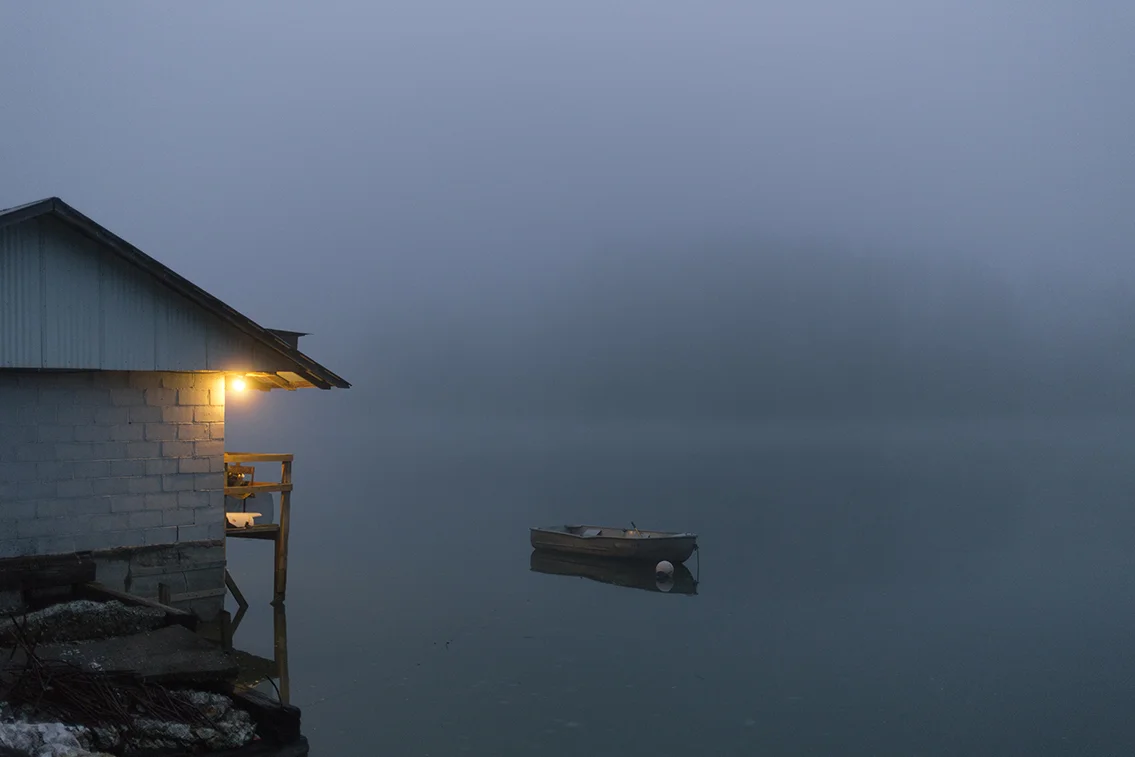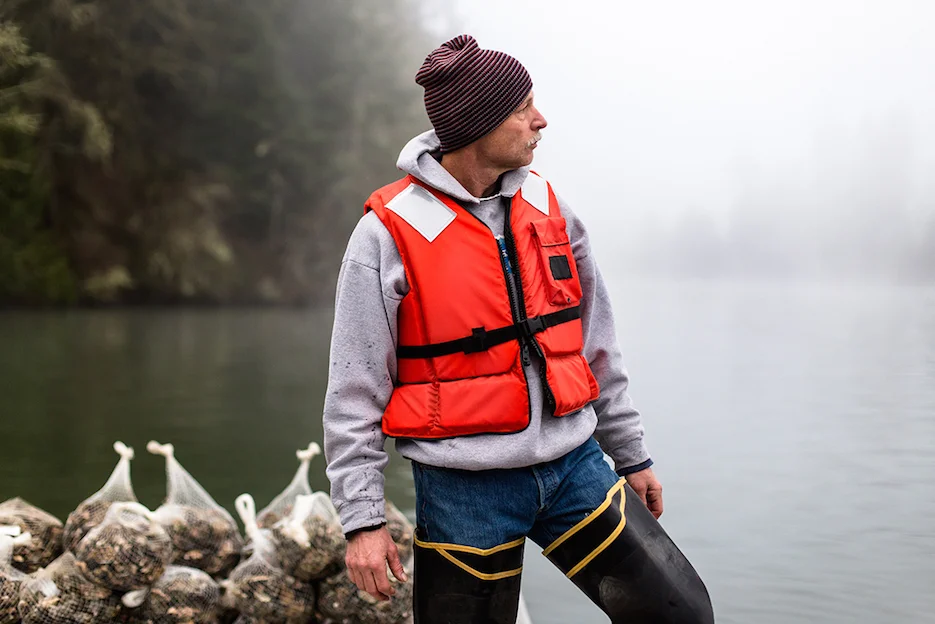If you’re one for a little meditation, you know of that blissful moment when thoughts finally silence and complete presence ensues. Arriving at Little Skookum Bay is essentially like immersing yourself in a whole landscape of that.
It's a rustic Eden backdropped by moss and dark evergreen. Where the mist hangs lightly in the air and shades of pink and lime illuminate the night sky. Where ducks share the water with orca whales. It seems to envelope all perception: poignant and mysterious, simple and sublime.
This dreamscape has produced some of the world’s most coveted oysters and, for hundreds of years, growers have worked the tides to harvest them. Brett Bishop is one such man, and he's about to guide us through a day in the life of an oyster farmer in this majestic part of the country.
“Okay,” Brett says, “it begins with sounds.”
“The sound of 10 million barnacles all going, tic tic tic—they make a squishy noise as they open and close, they make a squishy noise as you walk across the beach. It’s 10 million little guys just tic tic tic. The rain tapping on the hood of your rain gear. The sound of waves on the beach. And then the smells... You smell the tangy iodine salt water smell. You smell the salty mud that you’re digging in. The air is always fresh and clean. There are typically some animals watching what you’re doing. At nighttime, it would be a raccoon or a fox; sometimes ducks will come in and hunt underwater by the light of our lanterns. We’ve had orca out there with us.”
Such is life working a night tide—those hours during which the water of Little Skookum Bay recedes far enough to leave its oysters in the open, exposed to the hands of the farmers who have cultivated them for generations. Those hours during which, even if it’s 1 a.m. and pouring rain, shellfish growers leave their warm beds and head out into the cold dark. But it’s also a time during which Brett Bishop, decades earlier, realized that this was the oh-so-elusive “it” —this was what he was meant to do with his life.
“I was told to go out on the tide flats and rake up a bunch of oysters. And during the night, with the moon shining down on the fog over the land and the lanterns twinkling up and down the beach, I straightened up and I looked around the scene - I looked at the people next to me and it suddenly became very, very clear that there was no better life for me. No thing more interesting or more compelling. And I knew right then that I wanted to do this for the rest of my life.”
FAMILY TREES
The argument could be made that this decision was as much genetic as it was circumstantial. Brett and his family have been buying seed oysters, growing, harvesting and sending them from the family homestead that’s been operating for over a century. His parents, both over 100 years in age, have shared the property, their house just a short walk through the forest from Brett’s own home.
“I’m generation five, and my children are generation six. So when you look at the picture of me, my son and my dad, standing behind my dad, invisible, are two more generations that are past. And standing in front of my son is... who knows how many generations yet to be,” he says. “My job is to keep the farm in the family so that my children will have the choice of whether or not they want to live here and grow oysters like I did. No one can make that choice for them, but making that an option—that’s why I’m here.”
And by here, Brett means every single day. But thanks to the ephemeral nature of, well, nature, no day is quite like the last. Shellfish growers such as Brett have to work on the tide’s schedule—of which there is a documented book that growers treat like scripture.
BY THE BOOK
“Here in Puget Sound, we have two high tides and two low tides in every 24-hour period. One of the lows will be lower than the other one, and that’s the one where we work. So as the moon orbits the Earth, it pulls a bulge of water in a circular motion around the planet. And (whether it’s high or low tide—or somewhere in between) depends on where that bulge is. This is all in the tide book, it’s all predicted out for years in advance.”
There’s a 20 foot difference between the higher of the two high tides and the lower of the two lows, and it’s only during those absolute lows that the water pulls back far enough to expose the beach where the oysters are.
“If the (lower) tide is at night, then that’s when we work. If it’s in the middle of the day, that’s when we work.”
So while the rest of us acclimate to that consistent office schedule, Brett’s workday can only really start when he sees the oyster shells emerge from the surf. In the winter, that happens to be around 2 a.m..
The process is like picking produce: Brett and his crews set up on a freshly revealed area of the beach and begin to collect oysters that are “the right” size and shape, counting as they go,
headlamps lighting the way. Every collection of 103 gets wrapped into a net bag, and the process begins again.
“About three hours later, the tide comes back in and Mother Nature says yep, you’re done. (You) load them into the boat and take them back to the shop.”
Once in the shop, the oysters are cleaned, sorted, counted, bagged and packed. This is a familiar process to shellfish growers in most regions, but not all oysters are created equal.
A GOOD OYSTER
“When you’re looking for an oyster worthy of eating, it begins by looking at the shape of it. A nice oyster should have a clean shape, it should have a deep cup. It shouldn’t look like a potato chip. There should be some meat in it. So a good oyster is one that didn’t have to compete for food, and they don’t out here. The oysters here grow as fast as they can. They’re very fat, full of flavor and rich goodness.”
Of course, in this part of the Pacific Northwest, it’s that very flavor we’re interested in. Brett talks about oysters the way a sommelier talks about wine, describing Little Skookum Bay’s output as, “a flavor of cashew nuts, a crunchy aspect like cucumber, and a very buttery finish.”
Because it filters the water—and thereby the landscape—that flows around it, an oyster’s flavor is very much the byproduct of the environment in which it grew. This means that an oyster from Little Skookum Bay will taste different than one from Maine or Virginia.
The bay is shaped like an hourglass—wide at the head and mouth, and narrow in the middle. As water sweeps through the narrow section, it pulls away silt that would normally settle out of the water, leaving clean sand and gravel substrate in its wake. This creates an ideal habitat for oysters.
“If a person set out with a million bulldozers and a million excavators to dig a bay that would function as well as Little Skookum does, they couldn't have done it any better.”
It doesn’t take long to understand that the Bay treats its farmers just as well as its crop.
A HUMAN HAND
“When you arrive here you’ll notice a difference,” Brett notes. “From wherever you came, you’ll feel your heart slowing down, your mind absorbing more of the landscape. You just become more alive, more awake to the moment. Senses tingling.”
Brett’s obligation to an ever-changing schedule is a challenge on many levels, but he effuses the easy serenity of a man perfectly content with his life’s work. And that translates to his product.
“Any farmer, any craftsman that makes things with their hands, would have to feel fulfilled when something that you’ve made comes out perfect. It—there’s just no way to make it any better. The rest would be up to nature, but we did everything a human hand could do. And that’s an act of creation that’s fulfilling, stimulating, and that doesn’t change day to day, week
to week, year to year, decade to decade. It’s no less fulfilling to me now than it was the first time I did it 30 years ago.”
And in all that time, the night tide has sounded just about the same.
“Tic tic tic. Sorting and counting; people working their diggers into the beach. There’s chitchat and bantering going on — how was the game this week? What are your kids doing lately? How is your love life going?”
We ask Brett if the Bay feels quiet even with all those sounds. “Absolutely,” he says.
We explored Little Skookum Bay and the Pacific Northwest in the 2016 Lincoln MKX.










